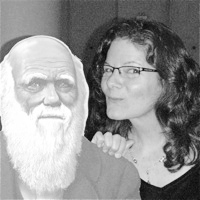by Nan Sincero

I’m a longtime FFRF member living in Marin County, Calif., (just across the Golden Gate Bridge from San Francisco). Marin is known for its natural beauty, excessive wealth, and liberal ideas. One would think it would be easy to find Godless, by Dan Barker, and many other atheist books on the shelves of its county’s libraries. Not.
When I did not find Godless on the shelf or in the county’s library computer system, I asked the librarian for a request card. I filled it out with title, author, etc., and handed it back in. In about a week’s time, I received the card in the mail saying it was ordered. Then about two weeks later I received an e-mail saying the book was at my local branch waiting for me, a 50¢ charge. And after I was finished reading it, it would be available to all. (I highly recommend Godless, by the way.)
I encourage all FFRF’ers to take a trip to your local libraries to request atheist texts. Look for Dan Barker, Richard Dawkins, Sam Harris, Neil deGrasse Tyson, Christopher Hitchens, Daniel Dennett, etc. If you don’t find them, request them. Libraries are a fabulous, and basically free, service. (In the U.S. we pay roughly $1 per year per person in taxes for them.) But, we need libraries that serve the needs of all of its citizens, including atheists.
Darwin’s 200th Birthday has brought us a number of new books on the man, his discoveries, evolution, and the journey of the Beagle. We’ve been hearing a fair amount about the new books for adults, but not much has been mentioned on the new books written about Darwin for children. Below are three reviews.
- One Beetle Too Many: The Extraordinary Adventures of Charles Darwin
by Kathryn Lasky, Illustrated by Matthew Truman
Candlewick Press, ages 9-12
This book is beautifully written; the illustrations are exceptional (almost 3D) and the information is abundant and accurate. The story covers Darwin’s life and highlights his journey on the Beagle and subsequent research, pointing to specific moments of evolutionary discovery. Lasky describes Darwin’s discoveries and surroundings in detail and with whimsical flair. She also acknowledges Alfred Russel Wallace and addresses the controversy of the Origin of Species. This book is a gem. Keep it in mind next time you’re shopping for a gift.
- What Darwin Saw: The Journey That Changed the World
by Rosalyn Schanzer
National Geographic, ages 9-12
What was National Geographic thinking? This book is an insult to Darwin and the children it was meant to educate and entertain. It’s graphically unsettling, with a mishmash of goofy illustrations and incomplete information. The text is heavy with Darwin quotes, but these brilliant and personal insights are displayed to correspond with anthropomorphized, cartoon-like animals. [i.e., Darwin: “This is the only butterfly I have seen that uses its legs for running” next to an illustration of a male butterfly chasing a female butterfly (complete with silly long eyelashes and a 50’s girly look) who’s screaming, “EEEK!” (This is distasteful on several levels.)] I can’t imagine Darwin, a stickler for accuracy, would be happy with this portrayal. This book dishonors his work.
- Charles Darwin
by Alan Gibbons, Illustrated by Leo Brown
Kingfisher, ages 4-8
This is an interesting take on the journey of the Beagle. Right in the beginning, Gibbons states that the book is a diary of a boy: “James and his pet (lemur) are fictional characters that I’ve created. They were not on the Beagle’s voyage, but the people in James’s diary did exist, and the events described are based on what actually happened.” Written for a young age group, it seems like a clever way to tell the story of Darwin and his discoveries, but I did find it a bit disconcerting, considering it’s a story about science.
But, the book covers a lot of ground and is visually pleasing, mixing real photos and illustrations. It is refreshing to see Fitzroy’s three Fuegians mentioned in the text, although it does not truthfully address the political and religious reasons surrounding the incident–somewhat understandable for the age group. After the story by boy James, the book includes sections that detail subjects like, “Life at Sea,” “Darwin’s Specimens” and “19th Century Scientists.” Kudos to Gibbons for listing three 19th century female scientists, but jeers for not mentioning Alfred Russel Wallace. The cover design is elaborate–a 3D iridescent (plastic) blue butterfly sitting atop a navigational chart–seeks to pay homage to Darwin (and sell books).

